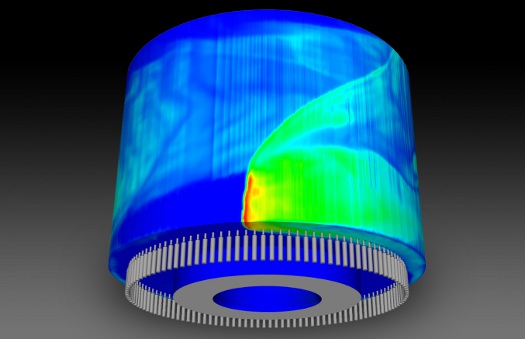 |
| June 11, 2019 | Volume 15 Issue 22 |
Designfax weekly eMagazine
Archives
Partners
Manufacturing Center
Product Spotlight
Modern Applications News
Metalworking Ideas For
Today's Job Shops
Tooling and Production
Strategies for large
metalworking plants
New computational model aims to accelerate hypersonic engine development

This three-dimensional numerical simulation captures complex combustion dynamics in a realistic, non-premixed, rotating detonation engine configuration. [Image: Argonne National Laboratory]
By Jo Napolitano, Argonne National Lab
Scientists at the U.S. Department of Energy's (DOE) Argonne National Laboratory, working in collaboration with Air Force Research Laboratory (AFRL) and Convergent Science, have created a new numerical modeling tool that allows for a better understanding of a powerful engine that could one day propel the next generation of airplanes and rockets.
Rotating detonation engines (RDEs) have received significant attention from the propulsion community in the last decade.
Unlike conventional gas turbine engines, which rely on subsonic constant pressure combustion, RDEs leverage high-intensity, self-sustaining detonation -- a supersonic reaction wave coupled with a shock -- to rapidly consume the fuel-air mixture, typically in a ring-shaped, cylindrical chamber.
With RDEs, there is an effective pressure gain: The intense and rapid energy release from detonation can be used to generate extremely high thrust from a relatively small combustor.
In addition, these engines are compact, contain no moving parts, are more efficient than conventional combustion systems, provide steady thrust at high frequencies, and can be integrated with existing aircraft and rocket engine hardware.
These unique features have made RDEs the subject of extensive research by various agencies, including the Air Force, Naval, and Army Research Laboratories; the National Aeronautics and Space Administration; as well as aerospace companies in the United States and abroad.
Despite the potential benefits they offer, practical implementation of RDEs has been elusive.
"The operation and performance of RDEs depends on many factors," said Brent Rankin, research engineer at AFRL. ?"The combustion behavior must be studied and optimized over a large design space for the technology to become practically viable."
Keith Bradley, Argonne's director of National Security Programs, said the lab is an ideal place to conduct this research.
"Argonne has unique abilities to do science at scale. Our scientific expertise, one-of-a-kind experimental facilities, and advanced modeling and simulation prowess allow for better, faster, and cheaper development as compared to more traditional, Edisonian approaches," he said.
Previous numerical simulations gave researchers fundamental insights into the combustion phenomena occurring in RDEs, but they were computationally very expensive, precluding rigorous studies over a wide range of operating conditions.
In an effort to solve this problem, Sibendu Som, computational scientist and manager of Argonne's Multi-Physics Computations group, and Pinaki Pal, mechanical engineer in Argonne's Energy Systems division, teamed up with Rankin at AFRL and researchers at Convergent Science to develop a computational fluid dynamics (CFD) model to predict the combustion behavior of RDEs.
"This work was geared toward developing a robust, predictive, and computationally efficient combustion model for RDEs," said Som.
VIDEO: Unlike standard gas turbine engines, rotating detonation engines, shown in simulation here, use high-intensity, self-sustaining detonation -- a supersonic reaction wave coupled with a shock -- to rapidly consume the fuel-air mixture, typically in a ring-shaped, cylindrical chamber.
Pal, who is leading Argonne's efforts, said computational modeling and simulation can play a major role in designing these engines.
"Very few studies have looked at modeling the full-scale RDE combustor geometry, which gives you the most accurate information -- primarily because these simulations can be very time consuming," he said. ?"The new model allows us to capture combustion behavior in realistic configurations accurately and at a reasonable cost."
The model was validated against data provided by Rankin's experiments at AFRL. The team demonstrated that the CFD model can capture RDE combustion dynamics under varying operating conditions.
"Such a model can be used to quickly generate simulation data over a large design space, which can then be coupled with advanced machine learning-based techniques to rapidly optimize the combustor design," Pal said. ?"We have demonstrated this approach for internal combustion engines, and it can be extended to RDEs as well."
Published June 2019
Rate this article
View our terms of use and privacy policy
